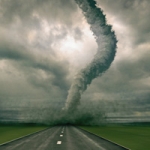Directive Blogs
The Small Business Guide for Preparing for Disaster
It's the start of the 2011 hurricane season, and with Hurricane Irene making contact with Atlantic coastlines this week, it certainly doesn't hurt to make sure your business is prepared for a disaster. Even if you are lucky enough to not be affected by these devastating storms, there are plenty of opportunities for nature to cause havoc on our way of life. It's never to late to put together a Disaster Recovery Plan (alternatively known as a Business Continuity Plan) in case a natural (or otherwise) disaster were to occur for you. Nobody wants to think a disaster might happen, but it isn't impossible. Here are a few steps small businesses can take to become better prepared.
Create an Emergency Disaster Kit
Everybody should have an emergency kit readily available with the basics. Sometimes you can purchase ready-made kits but it's just as easy to put one together yourself, and it's a good idea to encourage your employees to have their own, especially if they have special needs. Typical items that should be seen in an emergency disaster kit are: Water - Consider 1 gallon of water per person per day. If you have office water coolers, just keep a surplus of unopened jugs of water around.
Food - Keep a minimum of three days worth of food, remember that even canned foods have a shelf life and need to be checked and replaced every so often.
First Aid Kit - Make sure you have plenty of gauze, bandages, aspirin, antiseptics, tweezers, and the other standard items in your first aid kit. First Aid Kits can be found in stores, typically you should have one first aid kit for every 4 people.
Flashlights - It's best to have a few crank-powered lights, but having some battery powered flashlights and lanterns isn't a bad idea. Be sure to keep extra batteries.
Radio - Hand-crank powered is best.
Blankets
Whistle
Storage - Keep your emergency items in a water-proof, durable container. Keep inventory and replace food and supplies before they expire.
Establish the Disaster Plan
Come up with an evacuation plan in the event of a disaster. Designate a meeting zone outside of the building. Establish a telephone calling tree to stay in touch with employees. Clear communication is vital in an emergency.
Data Backup and Recovery
Remember, if there is an emergency like a fire or earthquake, you do not want to be wandering around inside the building trying to retrieve documents, data, or any other item. You will want to establish an off-site data archive that is up-to-date and fully tested. The old method of doing this was to bring backup tapes off-site. Unfortunately, backup tapes can be very unreliable and difficult to test, and of course, there's human error (oops, nobody has been taking the backup tapes off-site over the past 2 months). The best solution requires the least amount of user interaction. Utilizing a cloud storage solution combined with on-site disk backup can insure that your data is safe from anything nature throws at it. Directive offers a backup solution with this in mind, and can keep your data safely and securely stored at two off-site data centers. Disasters can happen. There's no place on Earth that is completely immune to mother nature, and there are always non-natural disasters like fires, accidents, electrical surges, and more that nobody wants to think could happen to them. Want help establishing your disaster recovery plan? Give us a call at 607.433.2200 or leave a comment if you have other tips on how businesses can prepare for an emergency situation.


